Brainymaniac
On this page, you find all documents, package deals, and flashcards offered by seller BrainyManiac.
- 725
- 0
- 29
Community
- Followers
- Following
2 Reviews received
756 items
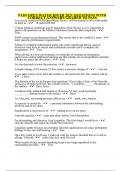
PADI OPEN WATER DIVER 2021 QUESTIONS WITH CORRECT ANSWERS GRADED TO PASS
As a newly certified PADI Open Water Diver, I will be trained to dive with buddy as deep as - 18 meters/60 feet Certain medical conditions can be hazardous while diving, so it is important to answer all questions on the Medical Statement honestly and completely - True PADI courses are performance-based. This means that to be certified, I must - meet specific performance requirements Failure to complete independent study can create significant delays, and my instructor may have ...
- Package deal
- Exam (elaborations)
- • 17 pages •
As a newly certified PADI Open Water Diver, I will be trained to dive with buddy as deep as - 18 meters/60 feet Certain medical conditions can be hazardous while diving, so it is important to answer all questions on the Medical Statement honestly and completely - True PADI courses are performance-based. This means that to be certified, I must - meet specific performance requirements Failure to complete independent study can create significant delays, and my instructor may have ...
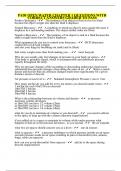
PADI OPEN WATER CHAPTER 1 QUESTIONS WITH CORRECT ANSWERS GRADED TO PASS
Positive Buoyancy - The tendency of an object to float or rise in a fluid because the object weighs less than the fluid it displaces Neutral Buoyancy - A condition in which an object's mass equals the mass it displaces in a surrounding medium. The object neither sinks nor floats. Negative Buoyancy - The tendency of an object to sink in a fluid because the object weighs more than the fluid it displaces What equipment do you use to control your buoyancy - BCD (buoyancy contro...
- Package deal
- Exam (elaborations)
- • 6 pages •
Positive Buoyancy - The tendency of an object to float or rise in a fluid because the object weighs less than the fluid it displaces Neutral Buoyancy - A condition in which an object's mass equals the mass it displaces in a surrounding medium. The object neither sinks nor floats. Negative Buoyancy - The tendency of an object to sink in a fluid because the object weighs more than the fluid it displaces What equipment do you use to control your buoyancy - BCD (buoyancy contro...
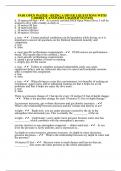
PADI OPEN WATER - BEING A DIVER I QUESTIONS WITH CORRECT ANSWERS GRADED TO PASS
b. 18 metres/60 feet - As a newly certified PADI Open Water Diver, I will be trained to dive with a buddy as deep as __________. a. 10 metres/30 feet b. 18 metres/60 feet c. 30 metres/100 feet d. 40 metres/130 feet a. true - Certain medical conditions can be hazardous while diving, so it is important to answer all questions on the Medical Statement honestly and completely. a. true b. false a. meet specific performance requirements - PADI courses are performance-based. This m...
- Package deal
- Exam (elaborations)
- • 8 pages •
b. 18 metres/60 feet - As a newly certified PADI Open Water Diver, I will be trained to dive with a buddy as deep as __________. a. 10 metres/30 feet b. 18 metres/60 feet c. 30 metres/100 feet d. 40 metres/130 feet a. true - Certain medical conditions can be hazardous while diving, so it is important to answer all questions on the Medical Statement honestly and completely. a. true b. false a. meet specific performance requirements - PADI courses are performance-based. This m...
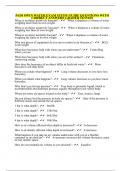
PADI OPEN WATER EXAM STUDY GUIDE QUESTIONS WITH CORRECT ANSWERS GRADED TO PASS
When is an object positively buoyant? - When it displaces a volume of water weighing more than its own weight. When is an object negatively buoyant? - When it displaces a volume of water weighing less than its own weight. When is an object neutrally buoyant? - When it displaces a volume of water weighing the same as its own weight. Why two pieces of equipment do you use to control your buoyancy? - BCD, Lead weight What does buoyancy help with when you are underwater? - ...
- Package deal
- Exam (elaborations)
- • 7 pages •
When is an object positively buoyant? - When it displaces a volume of water weighing more than its own weight. When is an object negatively buoyant? - When it displaces a volume of water weighing less than its own weight. When is an object neutrally buoyant? - When it displaces a volume of water weighing the same as its own weight. Why two pieces of equipment do you use to control your buoyancy? - BCD, Lead weight What does buoyancy help with when you are underwater? - ...
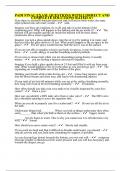
PADI FINAL EXAM QUESTIONS WITH CORRECT AND COMPLETE SOLUTIONS RATED A+
If an object is neutrally buoyant (does not sink or float) in fresh water; the same object placed into salt water would: - sink. Imagine you blow up a balloon, tie it off, and take it to the bottom of the swimming pool. What will happen to the balloon and the air inside it? - The balloon will get smaller and the air inside the balloon will be more dense (molecules move closer together). Imagine you turn a glass upside down, trap the air in it by putting it in water, and then you take...
- Package deal
- Exam (elaborations)
- • 3 pages •
If an object is neutrally buoyant (does not sink or float) in fresh water; the same object placed into salt water would: - sink. Imagine you blow up a balloon, tie it off, and take it to the bottom of the swimming pool. What will happen to the balloon and the air inside it? - The balloon will get smaller and the air inside the balloon will be more dense (molecules move closer together). Imagine you turn a glass upside down, trap the air in it by putting it in water, and then you take...
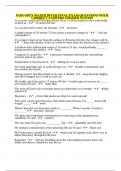
PADI OPEN WATER DIVER FINAL EXAM QUESTIONS WITH CORRECT ANSWERS GRADED TO PASS
As a newly certified PADI Open Water Diver, I will be trained to dive with buddy as deep as - 18 metres/60 feet As you descend in water, the pressure - increases A depth change of 10 metres/33 feet causes a pressure change of - 1 bar/ata (atmosphere) if you take 6 liters of air from the surface to 20 metres/66 feet, the volume will be - 2 litres (the density of the air would be three times the density at the surface) A balloon fully inflated and sealed at 10 metres/33 fee...
- Package deal
- Exam (elaborations)
- • 7 pages •
As a newly certified PADI Open Water Diver, I will be trained to dive with buddy as deep as - 18 metres/60 feet As you descend in water, the pressure - increases A depth change of 10 metres/33 feet causes a pressure change of - 1 bar/ata (atmosphere) if you take 6 liters of air from the surface to 20 metres/66 feet, the volume will be - 2 litres (the density of the air would be three times the density at the surface) A balloon fully inflated and sealed at 10 metres/33 fee...
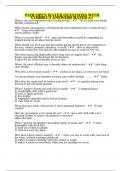
PADI OPEN WATER QUESTIONS WITH CORRECT ANSWERS RATED A+
What is the most important rule of scuba diving? - Do not hold your breath Breathe continuously What are the consequences of breaking the most important rule in scuba diving? - Lung overexpansion severe injuries, death What is a reverse block? - pain and discomfort caused by expanding air trapped inside an air space during ascent What should you do if you feel discomfort during ascent due to air expansion in the ears, sinuses, stomach, intestines, or teeth? - slow or stop ...
- Package deal
- Exam (elaborations)
- • 7 pages •
What is the most important rule of scuba diving? - Do not hold your breath Breathe continuously What are the consequences of breaking the most important rule in scuba diving? - Lung overexpansion severe injuries, death What is a reverse block? - pain and discomfort caused by expanding air trapped inside an air space during ascent What should you do if you feel discomfort during ascent due to air expansion in the ears, sinuses, stomach, intestines, or teeth? - slow or stop ...
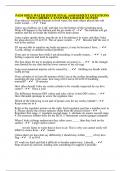
PADI OPEN WATER DIVER FINAL ASSESSMENT QUESTIONS WITH CORRECT ANSWERS GRADED TO PASS
If an object is neutrally buoyant in fresh water, the same object placed into salt water would... - Float I blow up a balloon, tie it off, and take it to the bottom of the swimming pool. What will happen to the balloon and the air inside it? - The balloon will get smaller and the air inside the balloon will be more dense I turn a glass upside down, trap the air in it by putting it in water, and then I take the glass down to 10 m/33 ft. The air space would... - Become half the size...
- Package deal
- Exam (elaborations)
- • 4 pages •
If an object is neutrally buoyant in fresh water, the same object placed into salt water would... - Float I blow up a balloon, tie it off, and take it to the bottom of the swimming pool. What will happen to the balloon and the air inside it? - The balloon will get smaller and the air inside the balloon will be more dense I turn a glass upside down, trap the air in it by putting it in water, and then I take the glass down to 10 m/33 ft. The air space would... - Become half the size...

PADI OPEN WATER DIVER CERTIFICATION QUESTIONS WITH CORRECT ANSWERS GRADED TO PASS
SCUBA - Self-contained underwater breathing apparatus What is the pressure change for each 10m/33ft of depth change? - 1 bar/1 ata/1 atmosphere What is the relationship between my depth in water and the pressure? - The deeper you go in water, the more the pressure increases Pressure is expressed as the weight of air What is the relationship between pressure, and the volume and the density of air? - As pressure increases, the gas volume decreases and the gas density increases ...
- Package deal
- Exam (elaborations)
- • 11 pages •
SCUBA - Self-contained underwater breathing apparatus What is the pressure change for each 10m/33ft of depth change? - 1 bar/1 ata/1 atmosphere What is the relationship between my depth in water and the pressure? - The deeper you go in water, the more the pressure increases Pressure is expressed as the weight of air What is the relationship between pressure, and the volume and the density of air? - As pressure increases, the gas volume decreases and the gas density increases ...
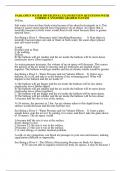
PADI, OPEN WATER DIVER,FINAL EXAM REVIEW QUESTIONS WITH CORRECT ANSWERS GRADED TO PASS
D float. Salt water is heavier than fresh water because it has dissolved minerals in it. This means it causes more upward force (buoyancy) on an object. An object that is neutrally buoyant in fresh water would float in salt water because there is greater upward force. See Being a Diver I - Buoyancy and Controlling Buoyancy. 1) If an object is neutrally buoyant (does not sink or float) in fresh water, the same object placed into salt water would A sink. B either sink or float. C do no...
- Package deal
- Exam (elaborations)
- • 16 pages •
D float. Salt water is heavier than fresh water because it has dissolved minerals in it. This means it causes more upward force (buoyancy) on an object. An object that is neutrally buoyant in fresh water would float in salt water because there is greater upward force. See Being a Diver I - Buoyancy and Controlling Buoyancy. 1) If an object is neutrally buoyant (does not sink or float) in fresh water, the same object placed into salt water would A sink. B either sink or float. C do no...

TNCC: TRAUMA NURSING PROCESS QUESTIONS WITH CORRECT ANSWERS RATED A+
NHA PCT MODULE 1 QUESTIONS WITH CORRECT ANSWERS